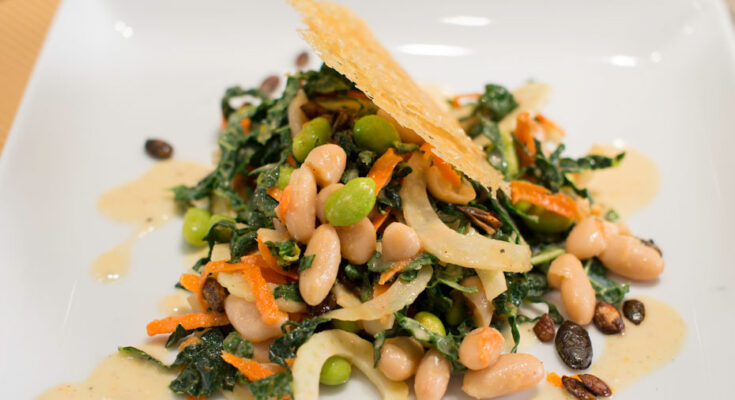Cannellini Beans Recipe: Cannellini beans might not be the flashiest ingredient in your pantry, but they’re definitely one of the most dependable and versatile. These ivory-colored beans, also known as white kidney beans, are beloved in Italian cuisine for their creamy texture and slightly nutty flavor. They’re the kind of ingredient you can rely on when you want a hearty, healthy, and budget-friendly dish.
So, why do these beans deserve a dedicated step-by-step guide? Because cooking them right transforms them from bland and boring to rich and deeply satisfying. Whether you’re using them in a stew, tossing them in a salad, or blending them into a dip, getting the basics down is essential.
Beyond taste, cannellini beans are a nutritional powerhouse. High in protein, fiber, and several key vitamins and minerals, they’re ideal for vegetarians, vegans, or anyone looking to cut back on meat without sacrificing protein. And let’s not forget their amazing ability to soak up flavor from whatever they’re cooked with—making them a sponge for herbs, garlic, olive oil, and spices.
Whether you’re starting from dried beans or opening a can for convenience, this guide walks you through everything. From prep to plate, you’ll have a delicious, foolproof cannellini bean recipe that you can whip up again and again.
Ingredients You’ll Need
Getting the ingredients right is half the battle. The beauty of a good cannellini beans recipe lies in its simplicity. You don’t need a laundry list of exotic ingredients—just a few pantry staples and fresh add-ons.
Core Ingredients:
- Cannellini Beans – 1 cup dried or 2 cans (15 oz each), drained and rinsed.
- Olive Oil – 2 tablespoons. Go for extra virgin if you can; it adds more depth.
- Garlic – 3 cloves, minced. The more, the better.
- Onion – 1 small, diced. Yellow or white works best.
- Vegetable or Chicken Broth – 1 to 1½ cups for simmering.
- Salt & Pepper – To taste.
Optional Add-ins for Flavor Boost:
- Bay Leaf – Adds a subtle earthy note during simmering.
- Fresh Herbs – Rosemary, thyme, or parsley elevate the flavor.
- Lemon Juice or Zest – For brightness and tang.
- Crushed Red Pepper Flakes – If you like a little heat.
- Parmesan Rind – Throw it in while simmering for a cheesy umami bomb.
If you’re going for a full meal, consider pairing these beans with roasted vegetables, grilled chicken, or even ladled over crusty bread. The ingredient list is flexible—don’t be afraid to get creative with what you have on hand.
How to Prepare Cannellini Beans
Cannellini beans can be used dried or canned, and each method has its own merits. Let’s break them down.
Using Dried Cannellini Beans
Dried beans take more time but reward you with unmatched texture and flavor. Here’s how to prep them:
- Sort and Rinse – Always check for small stones or debris before rinsing thoroughly under cold water.
- Soak – Soaking helps reduce cooking time and makes the beans easier to digest. You can do an overnight soak (8-12 hours) or a quick soak by boiling the beans for 2 minutes and then letting them sit for an hour.
- Cook – After soaking, drain and place beans in a pot. Cover with fresh water (about 2 inches above the beans), bring to a boil, reduce to simmer, and cook for 60–90 minutes. Don’t salt the water at this stage—it toughens the skins.
Using Canned Cannellini Beans
For those short on time, canned beans are a blessing. They’re already cooked and ready to use.
- Drain and Rinse – Always rinse canned beans to remove excess sodium and that goopy liquid.
- Use as You Would Cooked Beans – You can add them straight to your pan during the sautéing or simmering stage. Just remember they’re already cooked, so they don’t need much time.
Whether you choose dried or canned depends on your schedule and desired texture. Dried beans are great for weekend cooking; canned are perfect for quick weeknight meals.
Step-by-Step Cannellini Beans Recipe
Now comes the fun part—bringing everything together into a delicious dish. This step-by-step recipe focuses on flavor, simplicity, and versatility.
Step 1: Soak the Beans (if dried)
Start by soaking your dried beans overnight. This not only speeds up the cooking time but also helps the beans cook evenly and reduces the compounds that can cause bloating. After soaking, rinse them again before cooking.
Step 2: Cook the Beans
Place the soaked beans in a large pot and cover with fresh water. Bring to a gentle boil, then reduce to a simmer. Cook uncovered for 60–90 minutes, skimming off any foam that rises to the surface. Check for doneness by biting into a bean—it should be tender but not mushy.
Step 3: Sauté the Aromatics
In a separate large skillet or saucepan, heat olive oil over medium heat. Add diced onions and cook until translucent (about 5 minutes). Toss in the garlic and cook for another minute or two until fragrant. This is where your kitchen will start smelling incredible.
Step 4: Combine and Simmer
Add the cooked or canned beans to the pan with aromatics. Pour in broth to just cover the beans. Toss in a bay leaf or herbs if you’re using them. Let everything simmer gently for 15–20 minutes to marry the flavors. Stir occasionally and taste-test for salt and pepper.
Step 5: Serve and Enjoy
Remove the bay leaf and serve warm. These beans are great on their own, over toast, mixed into pasta, or served alongside meat or roasted vegetables. Garnish with fresh herbs, a drizzle of olive oil, or a sprinkle of cheese.
Serving Suggestions
Cannellini beans are the Swiss army knife of legumes. They’re hearty enough to stand on their own, but mild enough to complement all sorts of flavors and dishes. Whether you’re throwing together a simple lunch or looking to impress at dinner, there’s a way to plate these beans that fits the mood.
Pairing with Grains or Proteins
One of the easiest and healthiest ways to enjoy cannellini beans is by pairing them with grains. Brown rice, farro, quinoa, or even couscous make a fantastic base. Just spoon the beans over your cooked grain, drizzle with olive oil, and sprinkle on some herbs. Simple, satisfying, and nourishing.
If you’re not vegetarian, cannellini beans go wonderfully with grilled chicken, pan-seared salmon, or even steak. Their creamy texture contrasts perfectly with the chewiness of meat or the flakiness of fish.
Looking for a Mediterranean vibe? Serve them alongside grilled lamb with a side of tzatziki or over a warm pita with hummus and tabbouleh.
As a Standalone Dish
They don’t need any company if you don’t want them to have it. A steaming bowl of cannellini beans simmered with garlic, onion, and herbs can easily be the centerpiece. Add a fried egg on top, some chili oil or grated Parmesan, and you’ve got yourself a power-packed meal.
Don’t underestimate the power of beans on toast either. Rustic sourdough, lightly toasted and rubbed with garlic, topped with a spoonful of these creamy beans—it’s comfort food at its finest.
No matter how you serve them, don’t forget to finish with a final drizzle of quality olive oil or a squeeze of lemon. It ties everything together beautifully.
Tips and Tricks for Perfect Cannellini Beans
Making great cannellini beans isn’t rocket science, but a few key tips can elevate your dish from “meh” to “more, please!”
Avoiding Mushy Texture
One of the biggest issues people face when cooking beans is ending up with a mushy, overcooked mess. If you’re cooking dried beans, make sure to keep the simmer gentle. A hard boil will bust them open and break their skins. Keep them just below boiling, and start checking for doneness after an hour.
With canned beans, be especially gentle. They’re already cooked, so they just need a bit of warming and flavor infusing. Toss them around too much in the pan, and they’ll disintegrate.
Enhancing Flavor Naturally
Cannellini beans are flavor sponges, which is great—if you give them something good to soak up. Don’t skimp on the aromatics. Onions, garlic, and a few herbs go a long way.
Try simmering your beans with a parmesan rind or a strip of lemon peel for extra umami and brightness. Even a glug of wine added during the cooking process can bring depth.
Finish with fresh herbs like parsley, basil, or thyme, and always season to taste at the end. Beans often need more salt than you think, especially when you’ve cooked them in unsalted water.
A dash of acid—lemon juice or vinegar—right before serving brightens everything and makes the beans taste more alive.
Health Benefits of Cannellini Beans
Besides being tasty, cannellini beans are little nutrition bombs. Incorporating them into your meals regularly can do wonders for your health.
Rich in Nutrients
These beans are an excellent source of plant-based protein, making them a staple for vegetarians and vegans. Just one cup of cooked cannellini beans delivers around 15 grams of protein and a hefty dose of complex carbohydrates for sustained energy.
They’re also loaded with fiber—good for your gut and for keeping you full longer. That same cup packs roughly 11 grams of dietary fiber, helping regulate digestion and blood sugar levels.
Plus, cannellini beans offer a solid dose of essential minerals like magnesium, iron, and potassium, all of which support heart health and muscle function.
Good for Digestive Health
Thanks to their high fiber content, cannellini beans promote regular bowel movements and a healthy gut microbiome. The type of fiber in these beans acts as a prebiotic, feeding the good bacteria in your intestines.
Regular consumption can also help lower bad cholesterol levels, thanks to soluble fiber that binds with cholesterol in the digestive system.
In short, cannellini beans aren’t just filling—they’re fueling your body with some of the best plant-based nutrition out there.
Common Mistakes to Avoid
Even with a simple recipe like this, a few missteps can derail your dish. Let’s make sure you steer clear of these pitfalls.
Overcooking or Undercooking
This one’s huge. Overcooked beans turn into a mushy blob; undercooked ones are chalky and tough. The fix? Pay attention. Start checking your beans for doneness at the 45-minute mark (if dried). They should be tender but not split or falling apart.
If you’re using canned beans, remember—they’re already cooked. You’re just warming and seasoning them, so don’t let them sit in the pan for too long.
Skipping Seasoning
Beans love salt, herbs, spices—pretty much anything you throw at them. Don’t expect much flavor if all you’ve added is garlic and onion. Use broth instead of water when possible. Add herbs like rosemary, thyme, or oregano. Season as you go and taste at every stage.
Also, don’t forget the finishing touches. A splash of acid like lemon juice or vinegar, a sprinkle of herbs, or a bit of cheese can make all the difference in your final dish.
Variations of Cannellini Beans Dishes
Cannellini beans are like a blank canvas—you can create so many delicious variations with them depending on the season, cuisine, or your personal cravings. Let’s explore a few popular and creative ways to transform this humble ingredient into something memorable.
Cannellini Bean Soup
One of the most comforting ways to use cannellini beans is in a soup. Think of a warm, brothy bowl filled with tender beans, wilted kale, and aromatic vegetables like carrots and celery. This is a dish that’s not only soul-soothing but also packed with nutrients.
Here’s a basic outline: Start by sautéing onions, garlic, and carrots in olive oil. Add vegetable broth, a bay leaf, and a can of tomatoes. Toss in cooked or canned beans and simmer for 20 minutes. Add greens like spinach or kale in the last few minutes and finish with lemon juice and grated Parmesan.
You can tweak this to suit your taste—add sausage for extra protein or toss in small pasta like ditalini or orzo for a more filling version.
Cannellini Bean Salad
On the other end of the spectrum, there’s the light and refreshing cannellini bean salad. It’s a perfect make-ahead dish for lunch, picnics, or potlucks.
To make it, combine canned (drained and rinsed) beans with chopped red onion, cherry tomatoes, cucumber, parsley, and olives. Dress it with olive oil, lemon juice, salt, and pepper. Let it sit in the fridge for an hour so the flavors can meld.
You can even bulk it up with cooked quinoa, roasted veggies, or chunks of tuna for a Mediterranean-style twist. It’s colorful, protein-packed, and satisfying without being heavy.
Other creative options include mashed cannellini beans on toast with a drizzle of balsamic glaze, or turning them into a white bean dip flavored with roasted garlic and lemon. The versatility is endless.
Storing and Reheating
Let’s say you made a big batch (smart move)—now you’ve got to store and reheat it properly to enjoy those leftovers just as much as the first time.
Best Storage Methods
If you’re working with leftovers, let the beans cool to room temperature before storing. Place them in an airtight container and refrigerate. They’ll stay fresh for up to 5 days.
For longer storage, freeze them! Cannellini beans freeze really well. Just spoon them (with or without some of their cooking liquid) into freezer-safe containers or bags. Make sure to leave a little space at the top for expansion. They’ll last for about 2 months in the freezer.
If you’re freezing, it’s a good idea to portion them out into serving sizes. That way, you only thaw what you need.
How to Reheat Without Losing Flavor
When reheating from the fridge, you can warm your beans on the stove or in the microwave. On the stove, place them in a pan over medium-low heat, adding a splash of broth or water if they’ve thickened too much. Stir occasionally until heated through.
For the microwave, place the beans in a microwave-safe bowl, cover loosely, and heat in 1-minute intervals, stirring in between until warmed.
If reheating from frozen, it’s best to thaw overnight in the fridge. But if you’re in a rush, reheat gently on the stove with a little broth, stirring often to prevent sticking.
No matter how you reheat them, finish with a quick seasoning check—beans can lose a bit of flavor when stored. A sprinkle of salt or a fresh squeeze of lemon can revive them instantly.
FAQs about Cannellini Beans Recipe
1. Can I cook cannellini beans in a slow cooker or Instant Pot?
Yes! In a slow cooker, cook soaked beans on low for 6–8 hours or high for 3–4 hours. In an Instant Pot, pressure cook soaked beans for about 25 minutes, followed by a natural release.
2. Are cannellini beans the same as navy beans or great northern beans?
No, but they’re similar. Cannellini beans are larger and creamier, while navy beans are smaller and softer. Great northern beans fall somewhere in between.
3. What do cannellini beans taste like?
They have a mild, nutty flavor with a creamy texture. Their subtle taste makes them ideal for soaking up the flavors of the ingredients they’re cooked with.
4. Can I eat cannellini beans raw or sprouted?
No, raw or undercooked beans can be toxic. Always cook cannellini beans thoroughly before eating. Sprouting is possible but requires proper food safety practices.
5. Are cannellini beans good for weight loss?
Absolutely. They’re low in fat, high in fiber, and provide plant-based protein—making them very filling and great for supporting weight loss.
Conclusion
Cannellini beans are the unsung hero of the pantry. They’re budget-friendly, easy to cook, and endlessly versatile. Whether you’re cooking from scratch or grabbing a can off the shelf, you can whip up meals that are healthy, hearty, and incredibly flavorful.
With the step-by-step guide above, you now have all the tools to master this humble legume—from proper preparation to creative serving ideas. Whether you’re simmering a savory soup, tossing a light salad, or crafting a cozy bean stew, cannellini beans are here to make your meals more nourishing and delicious.
So next time you’re staring into your pantry wondering what to make, let those white beans inspire you. Trust me—once you’ve made them right, you’ll keep coming back for more.



